Tag archives: industry
Quantum technology 2.0
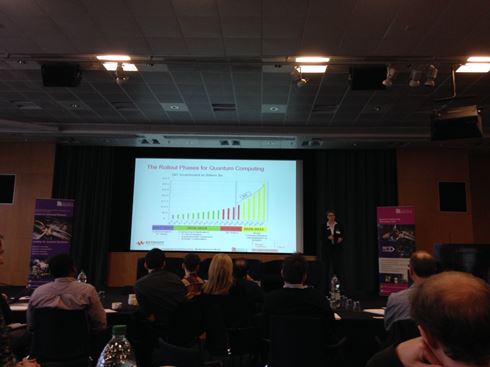
Niki Haines from Insight Technologies predicts the future of quantum computing.
By Michael Banks
Are we on the verge of a “quantum 2.0” revolution?
That was a question raised yesterday at an event that I attended at HP Labs in north Bristol, which was organized by the University of Bristol.
The day-long meeting featured a series of talks from industry about how quantum technologies are affecting business.
View all posts by this author | View this author's profile
Physics of food – the November 2016 issue of Physics World is now out
By Matin Durrani
If you love crisps – and frankly who doesn’t? – you’ll relish the cover feature of the latest issue of Physics World, in which features editor Louise Mayor tours the world’s biggest crisp factory at Leicester in the UK to see how physics is improving production of this yummy salty snack. The issue is now live in the Physics World app for mobile and desktop and will also be made available on physicsworld.com later this month.
Elsewhere in this special issue on physics and food, you can find out how electric fields could help to cut the fact from chocolate and discover why sound holds the key to our appreciation of what we eat.
You can also see how physicists – being masters of data-gathering, modelling and simulation – are ideally placed to develop products that are healthier, more nutritious and make more of our resources. Find out too how soft-matter physicists are crafting “functional” foods that promote feelings of fullness and satisfaction.
View all posts by this author | View this author's profile
Physics World 2016 Focus on Vacuum Technology is out now
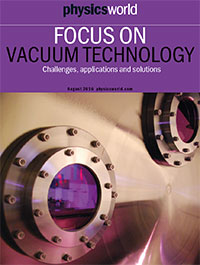 By Matin Durrani
By Matin Durrani
I’m pleased to say that the latest focus issue of Physics World, which explores the many fascinating applications of vacuum science and technology, is now out.
Plasma processing is a strong theme this year, as we discover why tools and techniques developed as part of the boom in semiconductor fabrication are now benefiting biomaterials. Elsewhere, we reflect on the strengths of the vacuum community with outgoing IUVSTA president Mariano Anderle.
And, as always, this vacuum focus issue provides a great chance to catch up with major industry players, including Pfeiffer Vacuum, Agilent, Honeywell and Edwards, to examine the latest instrument upgrades and trends across the sector.
View all posts by this author | View this author's profile
IBM wants you to use its quantum computer
By Hamish Johnston
Starting today, members of the public will be able to run programs on IBM’s quantum processor. Users can access the device – which comprises five superconducting quantum bits (qubits) – via the US-based company’s “IBM Quantum Experience” website.
Described as a “cloud-enabled quantum computing platform”, IBM says that users will be able to run algorithms and experiments on IBM’s quantum processor, manipulate individual qubits, as well as access quantum-computing tutorials and simulations.
View all posts by this author | View this author's profile
The field that could improve your research ‘impact’
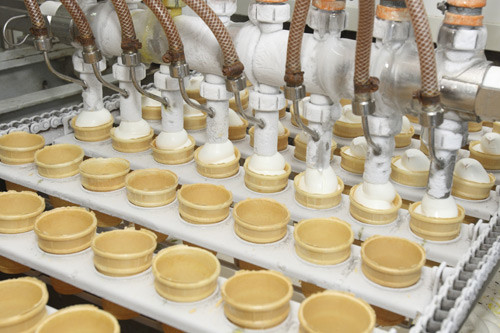
Where physics meets food: preparation of ice-cream in a factory. (Courtesy: iStockphoto/Leonid Shcheglov)
By Matin Durrani
As Physics World editor, I spend most of my time covering science that I have never been involved in. I might write articles about astrophysicists, interview atomic physicists or edit features by particle physicists, but it doesn’t mean I’ve ever done any research in those fields.
It was therefore a pleasant change last Friday to attend a summit organized by the Institute of Physics, which publishes Physics World, on physics in food manufacturing. Back in the 1990s, I did a PhD with Athene Donald at the Cavendish Laboratory in Cambridge on the physical properties of mixtures of gel-forming biopolymers – materials that apart from being interesting from a fundamental point of view are also relevant to the food industry.
Many foods, after all, are complex, multicomponent mixtures – and if you can understand how they behave, then you can create foods that are healthier, cheaper and perhaps even tastier too.
How to make money by quantum computing
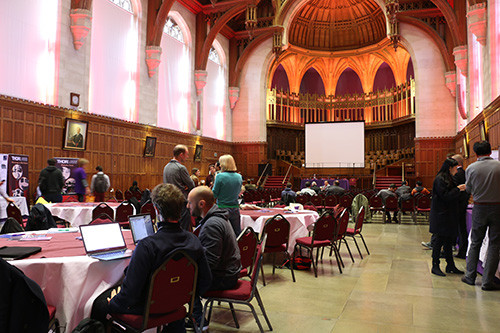
Quantum temple: will the congregation at Bristol’s Wills Memorial Building convert to quantum annealing?
By Hamish Johnston at the BQIT:16 conference in Bristol
Today I have made the short trip from the office to the University of Bristol, which is hosting the BQIT:16 conference on quantum information. I had been looking forward to the “Industry Perspective” session, which was headlined by Steve Adachi of the US defence supplier Lockheed Martin. Several years ago the firm was the first commercial buyer of what some consider to be the world’s first commercial quantum computer – a device made by Canada’s D-Wave Systems – and I wanted to know what Lockheed Martin was doing with it.
To say that D-Wave and its products are controversial is an understatement. Indeed, I wouldn’t be surprised if some delegates to this conference are brought to fisticuffs over D-Wave’s quantum annealing protocols later this evening in Bristol’s cider pubs.
View all posts by this author | View this author's profile
The firm that’s made no noise over gravitational waves
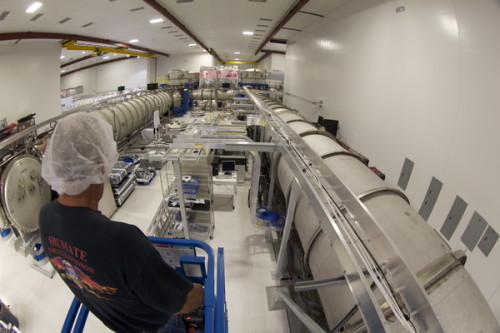
Power me up: Kepco’s kit was used to convert mains AC into DC for the lasers, electronics and other instrumentation at LIGO. (Courtesy: Caltech/MIT/LIGO Lab)
By Matin Durrani in Baltimore, Maryland, US
The exhibition hall at this year’s APS March meeting is so big that it can be hard to know who or what to see among the many companies displaying their wares or services. Fortunately, my colleague Joe Breck from IOP Publishing’s office in Philadelphia tipped me off about a great little story featuring Kepco Power Supplies, which is based in Flushing, New York.
I spoke to Mark Kupferberg, executive vice-president for power solutions at the firm, which was founded by his father and his two brothers in 1946 shortly afer the three had finished work on the Manhattan atomic-bomb project. Kepco mainly makes power supplies that convert mains AC into DC electricity, and has recently played a small but vital role in the discovery of gravitational waves, which were first predicted by Einstein 100 years ago.
Finding innovation in space

Way to go: Carlton House Terrace. (CC BY-SA 2.0 Richard Croft)
By Margaret Harris
I have a mental block about Carlton House Terrace. This elegant little street in central London is home to several of the UK’s national academies, including the Royal Society and the Royal Academy of Engineering (RAEng), and I’m sure I’ve visited it at least half a dozen times. Yet somehow, whenever I emerge from Charing Cross underground station in the middle of Trafalgar Square, I never know which way to go next.
Fortunately, this is the 21st century, so when the usual disorientation struck me yesterday on my way to an “Innovation in Space” event at the RAEng, I simply pulled out my smartphone. Within seconds, an app told me exactly where I was (plus or minus a few metres) and how to walk from there to 3 Carlton House Terrace. Minutes later, I was safely ensconced in the seminar room, nodding in agreement as the event’s chair, Sir Martin Sweeting, explained how space-related innovations – including, ahem, the network of satellites that make up the Global Positioning System (GPS) – have become an integral part of our daily lives.
View all posts by this author | View this author's profile
Marking time on precision engineering

Adventures in science: the Magna centre in Rotherham, UK.
By Susan Curtis
At a time when the UK steel industry is close to meltdown, it felt quite humbling to be standing inside a disused steelworks on the outskirts of Rotherham. In its heyday in the 1970s the colossal plant employed 3000 people and housed six electric arc furnaces that set new records for steel production. Since closing in 1993, the facility has forged a new identity as the Magna Science Adventure Centre, which offers visitors an insight into the steel-making process and its heritage in the area around Sheffield.
Recently, I was at Magna for the annual TRAM conference, which showcases the latest technology advances in the aerospace industry. Organized by the Advanced Manufacturing Research Centre (AMRC), one of the UK’s Catapult centres based at the University of Sheffield and supported by Boeing, TRAM highlights how aircraft makers and their suppliers are improving materials and manufacturing processes to reduce cost and enhance performance. But among the talk of powder metallurgy, high-performance machining and the factories of the future, a presentation by Nick English from the UK-based watchmaker Bremont highlighted manufacturing innovation at a much smaller scale.
View all posts by this author | View this author's profile
Comic book fusion, Nathan Myhrvold on innovation, and picking winners of the Global Physics Photowalk
By Hamish Johnston
The comic book artist Frank Espinosa and Princeton University’s Sajan Saini have joined forces to create a comic book called A Star For Us. The book begins with a brief history of our understanding of nuclear fusion in the Sun and goes on to chronicle the challenges of creating a mini-Sun here on Earth.
Espinosa and Saini – who is a physicist turned professor of writing – spent time with physicists at the Princeton Plasma Physics Laboratory. Espinosa says that he was impressed by the researchers enthusiasm for the future of fusion energy. “I was trying to channel that energy of hope,” he explains.
“The mood of the comic tries to really capture a sense of a vast cosmic scale being made palpable, being made into something that we can realize within our own hands,” says Saini. I agree and you can judge for yourself by downloading a PDF of the comic book free of charge.
The physicist and former chief technology officer at Microsoft, Nathan Myhrvold, has a nice essay in Scientific American about the roles of the private and public sectors in driving technological innovation. He explains that when Microsoft Research was created in 1991, the company was keen on not making the same mistakes as AT&T, IBM and Xerox – which were all in the process of winding down their world-famous research labs. The problem was that these firms funded research in areas that they were not immediately able to exploit commercially. Myhrvold points out that many of the technologies first developed in those labs – including the transistor and giant magnetoresistance data storage – made much more money for fast-moving competitors such as Microsoft than they did for the companies that did the basic research.
View all posts by this author | View this author's profile
